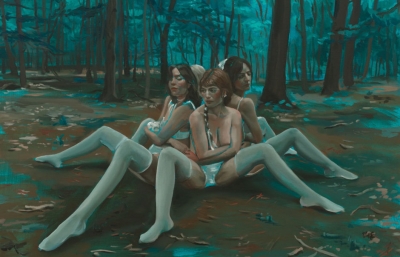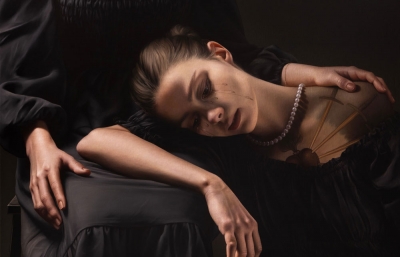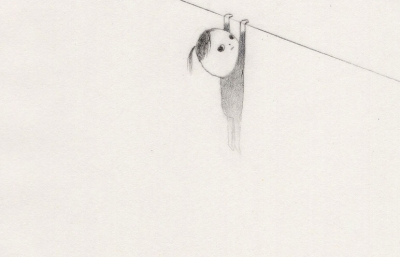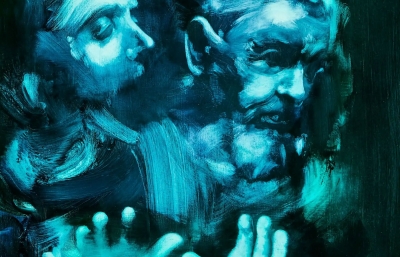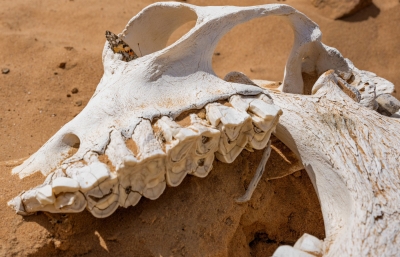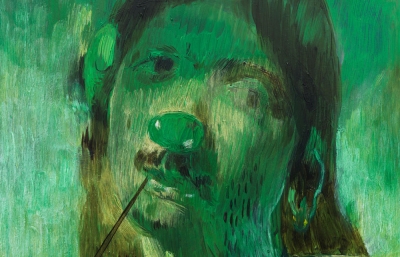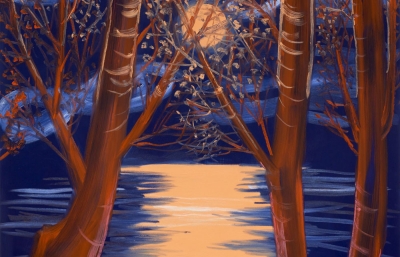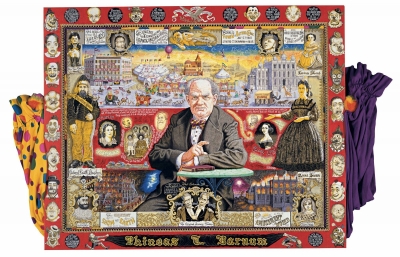New York-based artist Tania Marmolejo, fashion illustrator, commercial artist, author and painter, is a creative jack of all trades. Her Dominican and Scandinavian ancestry germinates a unique heritage that births a bold and arresting fine art style. On the eve of her solo show at GR Gallery in NYC opening June 10, 2022, Juxtapoz sat down with Tania to discuss how such a lineage influences her work, how movement plays into the practice, as well as some current artists on her radar.
Evan Pricco: Do you remember the first piece of art that moved you?
Tania Marmolejo: I believe it must have been paintings by my maternal grandmother in Sweden. She passed away before I was born, but her art—paintings and drawings—were amazing and always captivated me. I would sit and study them for hours in my grandfather’s house and my own. I now have her sketchbook, which is my most prized possession, and I still love looking through it. Her drawings definitely were the biggest influence on my own drawing and painting as I grew up. Both my grandmothers were artistic, but my maternal grandmother had the doodles and cartoonish style that were more my taste. I have always felt connected to her through my art.
You have both Dominican and Scandinavian lineage, and I wonder what you have gleaned from each of their artistic influences, especially because both are rich in folk art traditions. And, where do you see your ancestry converging when you paint?
I am definitely influenced by both lineages. Sometimes they present themselves separately, where a painting is definitely more “Caribbean” in color and theme, or “Scandinavian” in its moodiness and color story. The Dominican influence seeps through me in bright colors, especially the blues and greens of the mountains and nature around where I grew up. The incredible color of the water- turquoise, and sometimes a darker skin tone in the character. The Scandinavian influence shows in a darker palette in the backgrounds, also influenced by the Swedish children’s books about trolls and fairies that I grew up reading, and the blonder characters that many times are directly influenced by my mother. Sometimes in a painting I will mix the influences, and strange color combinations and moods arise, which I really like because that’s basically me: A muddy, colorful mix of influences.
What do you think is the hardest thing for an artist to explain about process? And here I am, asking you! I think what I mean is, what part of the process of making a painting, at what stage, is it just instinct?
I don’t mind explaining my process! I don’t like writing artist statements though, because my intentions and themes change as I work. Each artist has their own process that determines the outcome of their work, so it may be the most important part of creating. I do not sketch my works in advance, for example, as my work is completely expressionistic. I never know what the painting will actually look like in the end. I may have an idea, a certain plan, but as I paint, the expressions on the faces may start doing their own interesting thing - and I try not to force it. So many times, even if I look at a reference in the beginning, the expression, color and mood of the painting will turn out completely differently than I had initially planned. And I try to get as much of the painting done in one or two days as possible, even if I have to go slower afterwards to allow the paint to dry before making any details, since I work with oils. So it is a very quick, instinctive and purging initial process, and then it slows down a little and I really have to remember to be patient because I always want to start a new one.
Which artists are you looking at these days, and who is an influence?
I think more than artists today— though there are many I admire, I am more influenced by art movements from the past. Not in a direct sense, but more for the feeling— from Renaissance and Baroque movements for their play on light and dramatic backgrounds, to the German Expressionists and Abstract Expressionists for the pure expression in the work and experimentation with color. I look towards—backwards—to art history more than current art. I prefer museums that show human expression through the ages, more than contemporary art museums. But I do admire many artists today that do not necessarily directly influence my work, especially female artists who are breaking barriers and creating a language all their own. Cecily Brown, Mikalene Thomas, Dana Schutz, Cindy Sherman. Julie Mehretu, Kara Walker, Claire Tabouret, Genieve Figgis, Jesse Mockrin, Lisa Yuskavage…the list goes on. So many badass women artists!
Let's talk about doodling. You paint, and yet you have two books about drawing and just plain doodling. How does that play in your daily practice?
I used to draw much more than I do today, when I worked as print a designer for several years. I missed my own drawing time so much that I would doodle any chance I got, on post-it notes and any paper I could get my hands on. That is where the Doodle books come from, compilations from those times. But today, since I draw directly on the canvas when I paint— that has taken over—and though I also like to draw ink on paper and have exhibited them several times—I definitely do it less than painting. But the initial process of my paintings is a drawing (very loose, yet still a drawing), I suppose that counts!
How did working in a more commercial art setting enhance what you do with your gallery work? I think I can see a scale and bold use of colors that must have come from commercial work.
Actually, what I learned more from working in a commercial setting is the discipline it takes to consistently create. I’m always thinking of the next “design” for my paintings, and I work very diligently, constantly. I have to actually travel and remove myself from my studio to relax and think of something else. But the scale of my works is actually a direct consequence of having been restricted to smaller sized artworks for my designs. It felt great to blow everything up in size once I got home and could work on my own art. It’s also a direct consequence of being told my work was too feminine and that I should change it— and in protest I blew up the sizes of the works so you couldn’t escape the femaleness. But that’s a different story!
The experimental color combinations are also a consequence of working with textile designs. I try to have a surprising element of color somewhere in the painting, an accent that can tell a story or liven things up.
What was your focus for the new show at GR Gallery? What came in and out of the studio for you?
I am still working on paintings for the solo show at GR Gallery, and the desire for summertime to arrive seems to be subliminally working its way into my paintings. I had thought of painting the drama that follows me throughout my life (because it can be quite funny and I had been in a light- hearted mood), so there is some of that drama in the faces and color schemes. The title is Telenovela Life in honor of those overly dramatic Latin soap operas that were in the background at my friends’ homes growing up in the Dominican Republic. But looking at the art now I realize there are a lot of beaches and summer in there too… I must want it pretty bad.
Are you the character in the work?
The characters always have a lot of me in them because they are based on emotions I have or have had, experiences that have marked me, but they aren’t meant to be self-portraits. I create the alter-ego from an emotion and then set her free in the world to be herself and whomever she wants to be for the viewer. I was commenting on this with my husband, who mentioned that it was so incredible that they all had something that made them look like me, but not necessarily to each other. We came to the conclusion that they have the same mother- but different fathers. So there you go!
What's one thing you have done over the last year, either purchased or practiced, that has changed the way you work on your art?
I think the biggest thing that happened last year was Covid, and that changed a lot in my art. From basically doing nothing but paint because of the isolation, I remained very focused on the change in the art world that has suddenly brought many exhibitions and attention. I have so much work to do that it has changed my process and made me trust initial instincts more, allowing an expression to form without trying to change it—basically, to let the work flow in a quicker way, instinctively. In the past I could work on a piece for weeks, and I don’t have that luxury of time anymore (though I think it’s a good influence).
We have been thinking a lot about movement recently, because obviously the world was on standstill and we thought about movement in the abstract. Now the world is opening and at war and we are thinking about movement in the abstract once again. How does movement fit in your work?
That is a very interesting observation. Movement is always a part of my work, I like to express the feeling of the passing of time through a moving storm in the background, swirling clouds, ocean waves, leaves blowing, hair blowing in the wind… everything around the character is usually in movement and yet she stands still, watching you or having her moment. My work also evolves as I paint and experiment with it, so you will not easily see a “style” throughout a particular show because I allow the painting to change as I work. So, sometimes an exhibition can have several themes going, and a feeling of movement because it takes you to different places.I am quite distraught over the war in Ukraine, for example, and I can feel the characters’ faces becoming more somber, even though the background isn’t a war. I am not in that war, I can only be affected emotionally by what I see, and my inner self can’t ignore it. The paintings always evolve with my feelings and what happens around me, and that is a constant creative force and muse.
Tania Marmolejo’s solo show at GR Gallery in NYC opens June 10, 2022.











